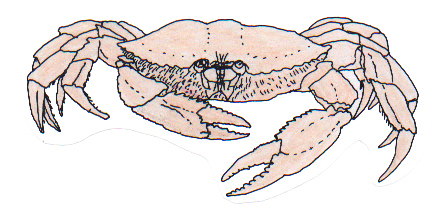 This collection of student work is from Frank Keim's classes. He wants to share these works for others to use as an example of culturally-based curriculum and documentation. These documents have been OCR-scanned and are available for educational use only.
This collection of student work is from Frank Keim's classes. He wants to share these works for others to use as an example of culturally-based curriculum and documentation. These documents have been OCR-scanned and are available for educational use only.Special | A | B | C | D | E | F | G | H | I | J | K | L | M | N | O
P | Q | R | S | T | U | V | W | X | Y | Z | ALL
The Dungeness Crab:The Dungeness Crab
(Cancer magister) (Pupsulek) The Dungeness crab is a well known shellfish which is found on the open coast and inside salt waters of Alaska. It can be found as far north as 61 degrees N. latitude and south to Magdelena Bay, Mexico. This crab is named for a coastal fishing village in Washington called Dungeness. It has a flattened body that is covered by a hard chitonous shell, and two if its 10 legs have large pincers. It is related to shrimp, lobster and other crabs. The Dungeness crab can be told apart from other commercially important crabs, such as the King crab and the Tanner crab, because its legs are smaller and shorter compared to its body size. A large male Dungeness crab can be nine inches or more in shell width. The predicted life span of this crab is approximately eight years. When the mature male and female mate, the female stores the sperm for several weeks or until her eggs are fully developed. She then projects the eggs out onto her abdominal flap where they are fertilized. A large female crab can carry 2.5 million eggs. After three or four years of being alive, the young crabs will be sexually mature. Dungeness crabs like living on a sandy or muddy bottom in salt water. However, they are very tolerant to salinity changes, so they can also be found in bays and estuaries where fresh water mixes with salt water. Large amounts of Dungeness crabs can be found in water of less than 10 fathoms, but they have been found in depths down to 100 fathoms. These shellfish can be caught for sport, but they are mostly caught commercially. Rose Lynn Fitka | |
|




